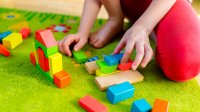Emphasizing the Importance of Play During Distance Learning
For young children, play is the primary vehicle for learning, and these ideas will help ensure that they continue to have rich play experiences at home.
Your content has been saved!
Go to My Saved Content.I miss watching my kindergarten students play. I miss their thoughtful ideas about how our play could go better, or why they thought certain problems kept arising. Classic examples include, “If everyone wants the purple block, there shouldn’t be just one purple block. It’s not fair,” and “If you say it without yelling, I can hear you better.”
I miss shout-outs at the end of the day, when students appreciated each other for kind acts. I miss how we all took play time so seriously. We knew that it would be better for all of us as a community if we could improve our play. Less crying and yelling and more laughing and talking made for a better experience for all of us.
Play provides opportunities for self-discovery and social connections; and it allows kids to try out ideas and use what they are learning in their academic subjects in a less pressured environment. Play develops imagination and speaking and listening skills and solidifies math and science concepts. Play is a time when mistakes can be deeply explored, because children are intrinsically motivated to repair a friendship or rebuild a structure.
In play, the goals are set by the students, and they are often exactly what the students are developmentally ready to do, like learning how to work in a group or emotionally regulate. This isn’t always true for the academic portions of our day.
How can we create playful experiences remotely? This may be more complicated than offering reading, math, and writing lessons online. Yet, if we believe play is a crucial part of learning, we owe it to our students to find a way to teach it remotely as well.
How to Keep Kids Playing
Emphasize with families that you care just as much about unstructured play time as you do about academic work: Share this article (or this one) about the importance of play. Include play in your daily or weekly assignments, and give it a suggested time frame, as you might with a reading lesson. Ask families to take photos of students at play and share them with you. For only children, this could look like something the child built or drew, or a fantasy game they invented. For children with siblings, this could look like a backyard game of tag or hide and seek, or communal fort-building. Ask parents to record the student talking about their play or take dictation, and to share that with you as well.
Schedule a one-on-one with each student, and express that all you are interested in learning is how they play at home: What materials do they use? What do they say about their play? Take careful notes, as you would record a literacy or math assessment.
Think about how what this child is saying teaches you something new about them that you could incorporate into a lesson later. In one of these one-on-ones that I held, I learned that one of my students loves Minecraft. Together, we learned how to draw a Minecraft character, and as we drew, he told me everything he could about Minecraft. Now, when I assign academic activities, I look for ways to incorporate his love of Minecraft.
During whole class meetings, share your interest in their play with all of your students: Ask questions like “What’s one thing you’ve built at home that you are proud of?” To reinforce lessons around making mistakes and taking risks, ask questions like “What was something you kept trying to do even though it was hard?” Keep the conversation focused on play, so that your whole class continues to see you giving it your value and attention.
Incorporate games into your online teaching: I’ve had success with I Spy, scavenger hunts, a game where each person tries to make one person smile, and freeze dance.
Share strategies for working through frustrations with your students and their families: Share whatever you used in the classroom to help kids emotionally regulate —whether it was taking a break, running around the playground, or talking it out with an adult. Suggest that a child have a place to record their frustrations, whether it’s a journal for drawing pictures, an adult to talk to, or a “tattle phone,” an object where they can “record” tattles to be listened to later by a hypothetical adult.
Ask your students to share problems that are arising and what strategies they are using to solve them. This will help communicate to your students that even though you’re not in the classroom together, you continue to be a community dedicated to solving problems and working together.
Someday, we will return to our classrooms, and when we do, I hope our students come back having played, taken risks, tried new things, dreamed, and discovered more about themselves and each other. We can help them do this by finding ways to encourage them to keep playing at home.
